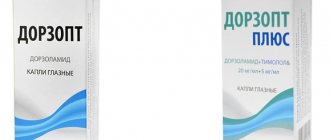Instructions for use TRITACE®
Prescribed internally.
It is recommended to take Tritace® every day at the same time of day.
Tritace® is taken with plenty of liquid, regardless of food intake. Food intake does not have a significant effect on the absorption of the active component of ramipril. The tablets must be swallowed whole (unchewed).
Adults
Patients treated with diuretics
Initiation of Tritace® may be accompanied by hypotension; this is more common in patients treated with diuretics.
The lack of salts and fluid in the body must be pre-corrected before starting Tritace® treatment; diuretics should be previously limited or discontinued, no later than 2-3 days.
Treatment of patients who have not stopped taking diuretics should be started with the smallest single dose of 1.25 mg ramipril. It is necessary to monitor kidney function and serum potassium levels. Subsequent dosage of Tritace® should be adjusted in accordance with the target blood pressure level.
Treatment of arterial hypertension
The dosage is calculated depending on the expected therapeutic effect and tolerability of the drug by the patient in each specific case.
Tritace® can be used either as monotherapy or in combination with other classes of drugs for the treatment of hypertension.
Initial dose
Treatment with Tritace® should be started with an initial dose of 2.5 mg daily.
In patients with a highly activated RAAS, a significant decrease in blood pressure may follow the initial dose. For such patients, the recommended starting dose is 1.25 mg, and initiation of treatment should be carried out under medical supervision.
Titration of an individual maintenance dose
The dose can be doubled at intervals of 2-4 weeks to achieve the target blood pressure level. The maximum daily dose is 10 mg. The daily dose is taken 1 time/day.
Prevention of cardiovascular accidents
Initial dose
The recommended starting dose is 2.5 mg Tritace® 1 time/day.
Titration of an individual maintenance dose
The dose is gradually increased depending on the patient's tolerance of the active substance. It is recommended to double the dose after 1-2 weeks of treatment, and after the next 2-3 weeks, increase the maintenance dose to 10 mg Tritace® daily.
Dosage recommendations should also be used in patients previously treated with diuretics.
Secondary prevention in patients with acute myocardial infarction with clinical
signs of heart failure
Initial dose
After 48 hours following myocardial infarction in clinically and hemodynamically stable patients, the recommended initial dose is 2.5 mg 2 times a day for 3 days. If the initial dose of 2.5 mg is not tolerated by the patient, it is necessary to prescribe 1.25 mg 2 times / day for 2 days before increasing the dose to 2.5 mg and 5 mg 2 times / day. If the dose cannot be increased to 2.5 mg 2 times / day, treatment should be discontinued.
Dosage recommendations should also be used in patients previously treated with diuretics.
Titration and individual maintenance dose
The daily dose is sequentially increased, doubling it at intervals of 1-3 days until a maintenance dose of 5 mg 2 times a day is reached.
It is recommended to divide the maintenance daily dose into 2 doses.
The maximum daily dose is 10 mg.
If a decision is made to treat Tritace® in a patient with severe (grade IV on the NYHA scale) chronic heart failure after myocardial infarction, it is recommended to start with a dose of 1.25 mg 1 time/day. The dose should be increased with extreme caution.
Treatment of kidney diseases
In patients with diabetes and microalbuminuria
Recommended starting dose
– 1.25 mg Tritace® 1 time/day.
The dose is sequentially increased depending on the patient's tolerance of the active substance. It is recommended to double the daily dose to 2.5 mg after 2 weeks of treatment, and then to 5 mg after the next 2 weeks.
In patients with diabetes and at least one cardiovascular risk factor
Recommended starting dose
– 2.5 mg Tritace® 1 time/day.
The dose is sequentially increased depending on the patient's tolerance of the active substance. It is recommended to double the daily dose to 5 mg after 2 weeks of treatment, and then to 10 mg after the next 2-3 weeks. The maximum daily dose is 10 mg.
In patients with nondiabetic nephropathy with macroproteinuria ≥ 3 g/day
Recommended initial
dose – 1.25 mg Tritace 1 time/day.
The dose is sequentially increased depending on the patient's tolerance of the active substance. It is recommended to double the daily dose to 2.5 mg after 2 weeks of treatment, and then to 5 mg after the next 2 weeks.
Treatment of symptomatic heart failure
Initial dose
For patients receiving diuretic therapy, the recommended initial dose is 1.25 mg Tritace 1 time / day.
Titration of an individual maintenance dose
It is recommended to double the dose of Tritace every two weeks to a maximum daily dose of 10 mg. It is preferable to divide the daily dose into 2 doses.
Patients
with impaired renal function
The daily dose for patients with impaired renal function is prescribed taking into account QC:
- if CC ≥ 60 ml/min, there is no need to adjust the initial dose (2.5 mg daily), the maximum daily dose is 10 mg;
- if CC is within 30-60 ml/min, there is no need to adjust the initial dose (2.5 mg daily), the maximum daily dose is 5 mg;
- if CC is in the range of 10-30 ml/min, the initial dose is 1.25 mg daily, and the maximum daily dose is 5 mg;
- in patients with hypertension undergoing hemodialysis: ramipril is poorly dialyzable; the initial dose is 1.25 mg daily, and the maximum daily dose is 5 mg; the drug must be taken several hours after hemodialysis.
Patients with liver dysfunction
Treatment of such patients should be carried out with extreme caution and only under medical supervision. The maximum permissible daily dose in such cases is 2.5 mg Tritace®.
Elderly patients
Initial doses should be lower and administered more gradually due to the increased risk of adverse reactions, especially in elderly and debilitated patients. The recommended initial daily dose is 1.25 mg Tritace®.
Children and teenagers under 18 years of age
Tritace® is not recommended for use in children and adolescents under 18 years of age due to insufficient relevant data on the safety and effectiveness of the drug.
Release form
Tritace Plus is available in tablet form.
5 + 12.5
The tablets are oblong, pink in color, and have a dividing line on each side. At the top there is a stamp 41/AV. Single dark inclusions are allowed.
10 + 12.5
The tablets are oblong, orange in color, with a dividing line on both sides. At the top there is a stamp 42/AY. Single dark inclusions are allowed.
5 + 25
Tablets are almost white, cream-colored with a dividing line, oblong in shape. There is a company logo and HNW stamp on both sides.
10 + 25
Pink tablets, oblong in shape. There is a dividing line on both sides. Stamped 39/AV on top. Single dark specks are allowed.
Tritace Plus price, where to buy
The cost of the medication depends on the combination, pharmacy chain and region of sale.
The average price of Tritace Plus in Russia is 600 rubles.
- Online pharmacies in UkraineUkraine
Pharmacy24
- Tritace plus 10 mg/12.5 mg N28 tablets Sanofi-Aventis S.p.A.,Italy/Sanofi S.P.A.Italy
206 UAH.order - Tritace plus 5 mg/12.5 mg No. 28 tablets Sanofi-Aventis S.p.A., Italy
141 UAH order
special instructions
An assessment of the functional state of the renal system before starting antihypertensive therapy with Tritace Plus is mandatory. The special observation group includes patients with lesions of the renal vascular system (stenosis). Creatinine and urea levels are the main indicators of the condition of the renal system.
In chronic renal failure, hyperkalemia may occur. With pathology of the hepatic system, the formation of the active metabolite slows down and the metabolic .
The risk of low blood pressure increases significantly in patients who are on a salt-free (or low-salt) diet. Symptomatic hypotension develops with decreased blood volume.
In transient forms of arterial hypotension, therapy with Tritace Plus can be carried out only after stabilization of blood pressure.
In patients undergoing hemodialysis using special dialysis membranes such as AN69, the risk of anaphylactoid responses and hypersensitivity increases. Similar reactions were observed when apheresis of LDL was performed with dextran sulfate.
Overdose
- weakness;
- dry mouth;
- bradycardia;
- drop in blood pressure;
- drowsiness;
- changes in water and electrolyte balance;
- shock;
- stupor;
- acute renal failure.
Therapy: the patient is placed in a horizontal position, legs are raised. Gastric lavage, administration of sodium sulfate and enterosorbing medications in the first 30 minutes after poisoning are effective.
For bradycardia, a pacemaker is used; If there is a sharp drop in blood pressure, catecholamines are administered intravenously. Hemodialysis has not proven effective.
Side effects
The cardiovascular system:
- arrhythmia;
- drop in blood pressure;
- orthostatic form of hypotension;
- tachycardia;
- myocardial infarction;
- angina pectoris.
Genitourinary tract:
- decreased libido;
- proteinuria;
- decreased diuresis;
- increased severity of symptoms of renal failure.
Nervous system:
- nervous excitability;
- ischemic changes in the brain;
- dizziness;
- weakness;
- paresthesia;
- increased drowsiness;
- anxiety;
- anxiety;
- sleep disorders, insomnia;
- emotional instability;
- fainting;
- confusion;
- depressed mood;
- limb tremors.
Sense organs:
- change in taste perception;
- visual disturbances;
- vestibular disorders;
- noise in ears.
Digestive tract:
- thirst;
- vomit;
- diarrhea syndrome;
- nausea;
- stomatitis;
- glossitis;
- dry mouth;
- constipation;
- epigastric pain;
- cholestatic jaundice;
- intestinal obstruction;
- hepatitis;
- loss of appetite.
Respiratory system:
- bronchospasm;
- dry non-productive cough;
- sinusitis;
- rhinitis;
- dyspnea;
- rhinorrhea;
- bronchitis.
Allergic responses:
- angioedema of the tongue, lips, laryngopharynx or on the facial part of the head;
- skin rashes;
- angioedema of the extremities;
- serositis;
- pemphigus;
- Lyell's syndrome;
- photosensitivity;
- vasculitis;
- exfoliative dermatitis;
- skin itching;
- hives;
- myositis;
- arthritis;
- onycholysis;
- eosinophilia.
Blood-forming organs:
- pancytopenia;
- decrease in hemoglobin;
- agranulocytosis;
- thrombocytopenia;
- hemolytic anemia;
- erythropenia.
Possible effect on the fetus:
- deformation of the skull bones;
- hyperkalemia;
- detection of antinuclear antibodies;
- hyponatremia;
- limb contracture;
- hyperazotemia;
- changes in the functioning of the renal system;
- drop in blood pressure;
- oligohydramnios;
- hypoplasia of the skull bones.
Laboratory reactions:
- detection of antinuclear antibodies;
- hyperkalemia;
- hyperazotemia;
- hypercreatininemia;
- hyperbilirubinemia;
- increase in ALT, AST, bilirubin .
Other reactions:
- hyperthermia;
- convulsions;
- increased sweating;
- alopecia.
Negative reactions characteristic of Hydrochlorothiazide:
- arrhythmia;
- irritability;
- confusion;
- lability of psyche and mood;
- hypochloremic alkalosis;
- diarrhea syndrome;
- cholecystitis;
- tachycardia;
- anemia (aplastic, hemolytic);
- orthostatic hypotension;
- epigastric pain;
- sialadenitis;
- pancreatitis;
- anorexia;
- hyperuricemia;
- hyperglycemia;
- exacerbation of gout;
- necrotizing vasculitis;
- skin rashes;
- pneumonitis;
- pulmonary edema of non-cardiogenic origin.
Contraindications
- renal artery stenosis (bilateral);
- angioedema;
- individual hypersensitivity;
- mitral stenosis with hemodynamically significant changes;
- primary hyperaldosteronism;
- pregnancy;
- stenosis of the renal arteries with a solitary kidney;
- breast-feeding;
- condition after kidney transplantation;
- aortic stenosis with hemodynamically significant changes;
- hemodialysis , which uses AN69 type dialysis membranes;
- hyponatremia;
- hypercalcemia;
- gout;
- pathology of the renal system;
- diabetes mellitus (severe);
- hypokalemia (refractory form).
Relative contraindications:
- severe damage to the cerebral and coronary arteries (with a sharp drop in blood pressure, blood flow may be disrupted);
- ventricular arrhythmias;
- hyponatremia;
- liver failure;
- heart failure;
- unstable form of angina;
- “pulmonary heart” (decompensation);
- hyperkalemia;
- renal failure;
- elderly age;
- vomiting, diarrhea syndrome and other conditions accompanied by a decrease in blood volume;
- inhibition of bone marrow circulation;
- systemic pathology of connective tissue;
- IHD;
- hypercalcemia;
- hepatic cirrhosis;
- diabetes.




